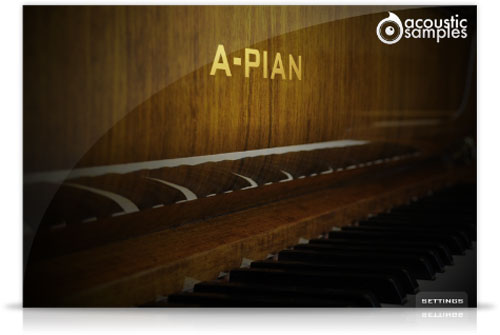You're currently on:
A-Pian V2, old french Gaveau piano
The A-Pian Grand piano is and old french Gaveau piano. Gaveau was a French piano manufacturer. The company was established in 1847 in Paris and used to be one of the three largest piano makers in France (after Érard and Pleyel).
This particular piano was build in 1960 and is reffered to as a "crapaud" ("Petite Grand" in english), which means that it's a little smaller than a "quart de queue" (baby grand).
It has a very particular sound, very bright and full of inharmonicity in the bass due to the short lenght of the strings.
This library was our first attempt at finding new ways of sampling a piano. We tried to reduce the size and still keeping the most important parts.

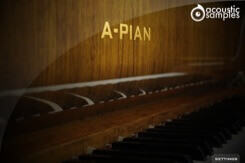
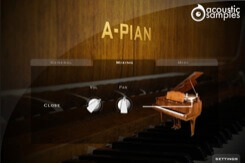

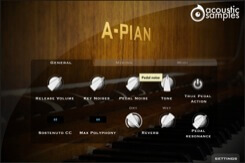
You can adjust:The release Volume: the sound produced when you release a key if a note was going on.
The Key Noises: the sound produced when you release a key and no corresponding sustain was played.
The Pedal Noise: the sound produced when you press or release the pedal, it adds a lot to the realism.
The Tone: a simple way to make the piano sound brighter or darker.
The True pedal action, it is a feature that allows you to play a chord without the pedal and then hear the resonance of the whole piano when you press the pedal (without releasing the keys).
The sostenuto CC, also called the middle pedal. You can sustain selected notes, while other notes remain unaffected.
The polyphony. If you lower the buffer or simply want to be light on CPU, then increase or lower this value.
The Reverb. We use a convolution reverb and you can adjust the dry and wet parts separately.
The Pedal Resonance. It is the amount of resonance during pedal down.
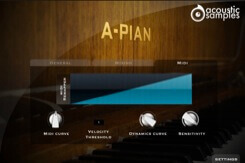
Midi settings
In the midi panel, you have access to all of the midi controls to help you adjust the library to your controller or playing style:The MIDI remapper allows you to assign any input velocity to any output velocity.
The MIDI curve controls the midi remapper and will give it a concave or convex shape thus changing a "MIDI sensitivity".
The Velocity Threshold is simply the minimum velocity that you will have to play to hear the piano, it is present on a real piano.
The Dynamics curve changes the volume curve of the library.
The Sensitivity will set the minimum volume for velocity 1 and give you access to all the dynamics that you want.
Technical Description
3 Velocity layers for the sustain.
3 Velocities for the release.
Pedal down resonance and true pedal action.
Key noises samples.
Sustain pedal noises (up and down), triggered automatically.
Advanced UVI scripting giving you access to a simple yet powerfull interface and advanced features.
iLok or computer based copy protection
![]()
![]()
You can register your library to your computer or to an iLok key. All of our libraries are protected with the iLok system, and you can use our libraries with or without an iLok usb key. Both V1 and V2 iLok usb keys are working with our products. To authorize your library, you will need to download the iLok authorization manager from here: https://www.ilok.com/ilm.html and simply authorize your iLok key or your computer to use the library.

Registration
![]()
Once your order is complete, you will be provided with a serial number.
You will then be able to register it to your iLok account from Acousticsamples' website (link will be provided to you when you complete checkout)
| Variant | 1 |





